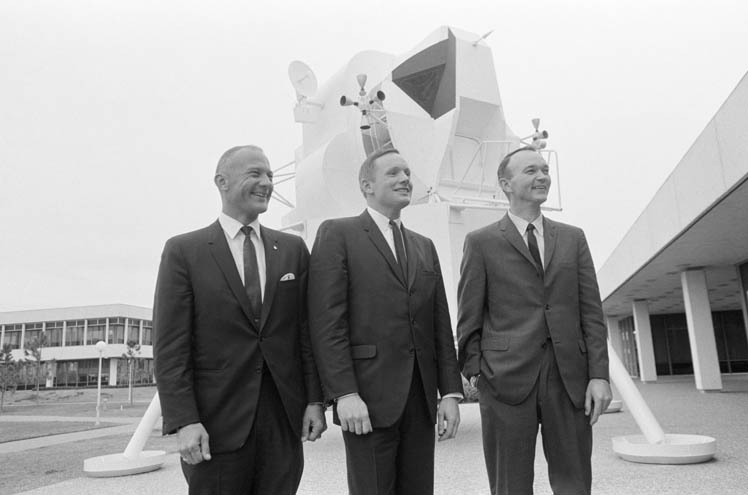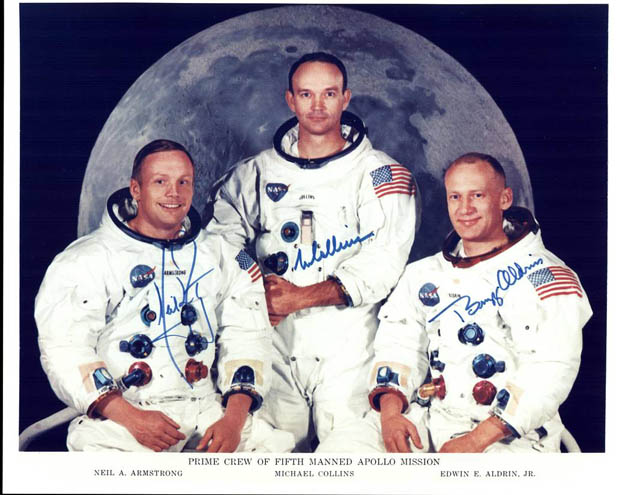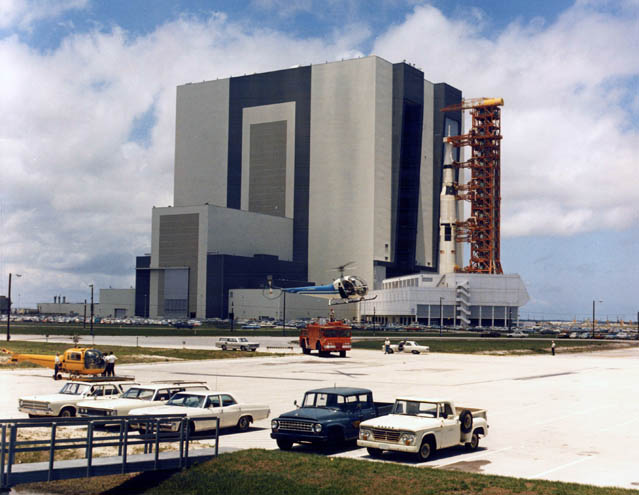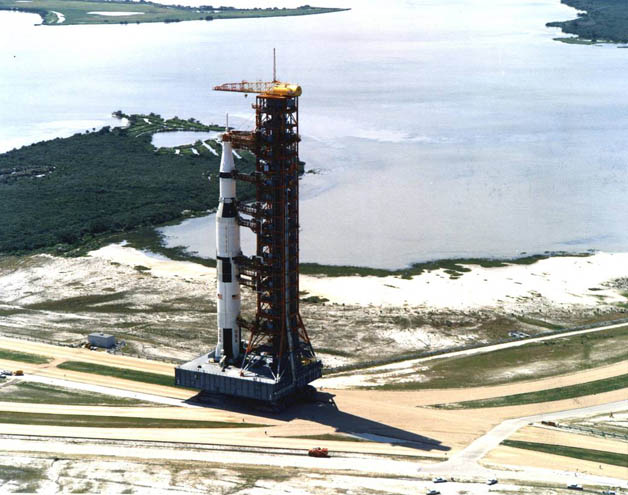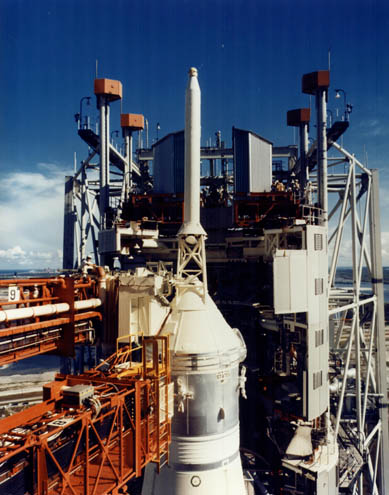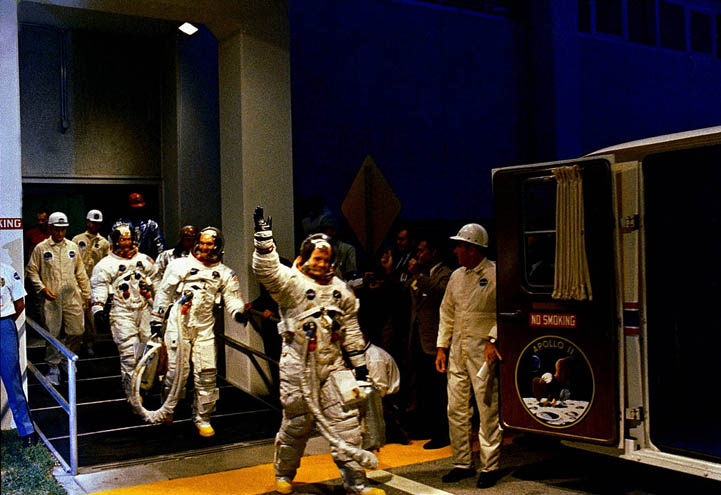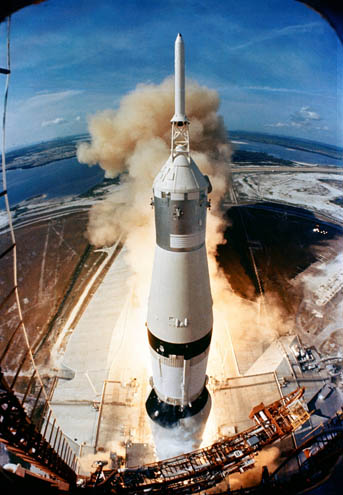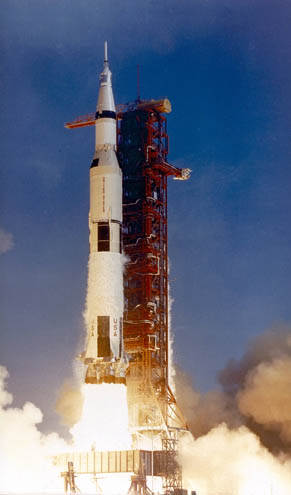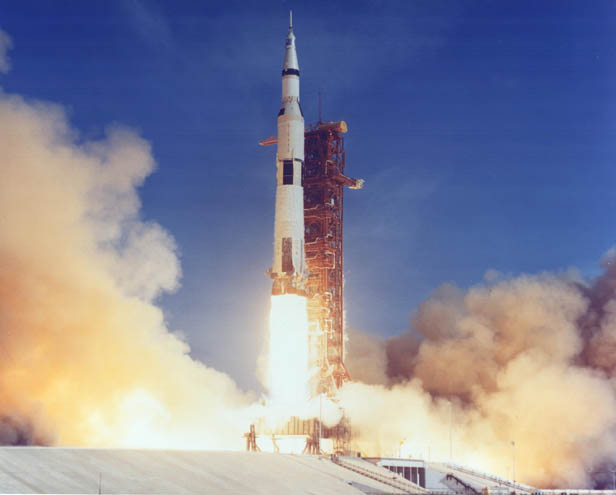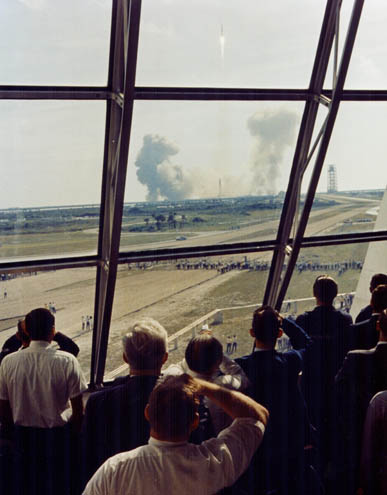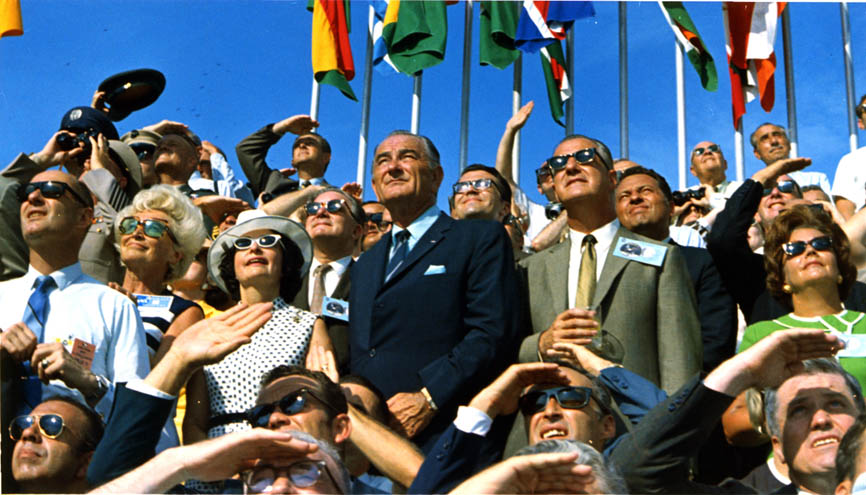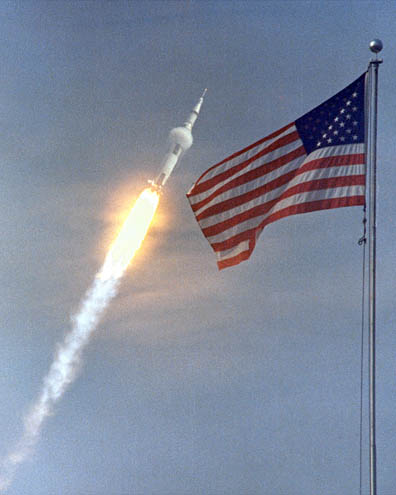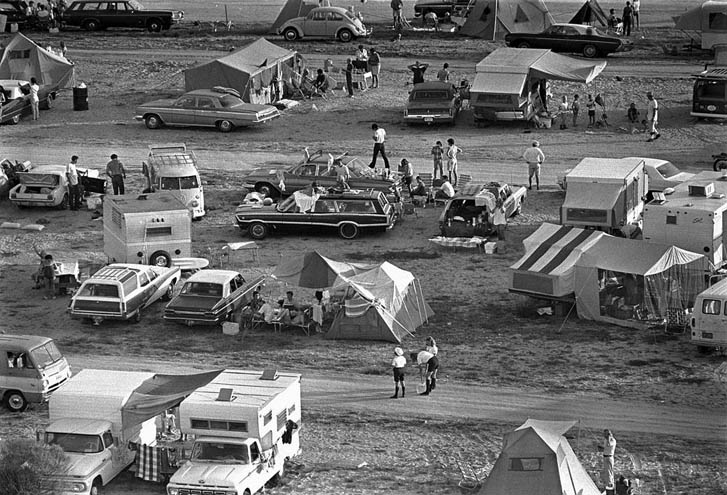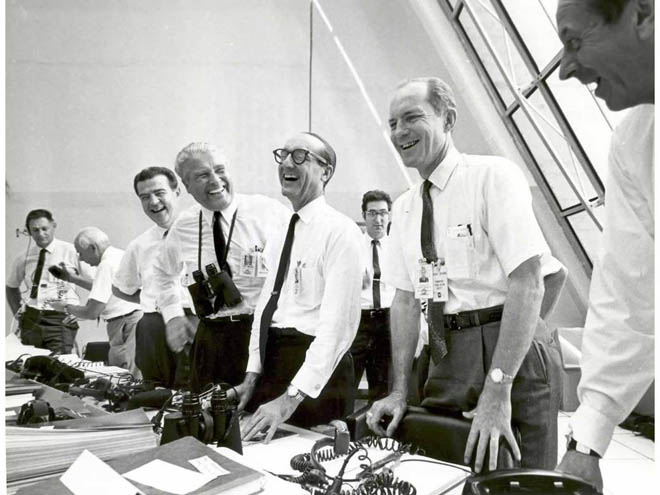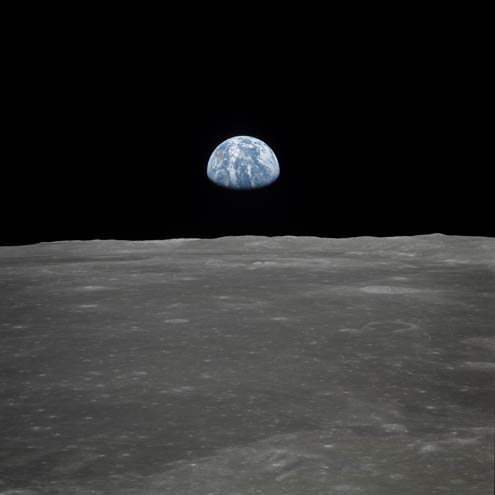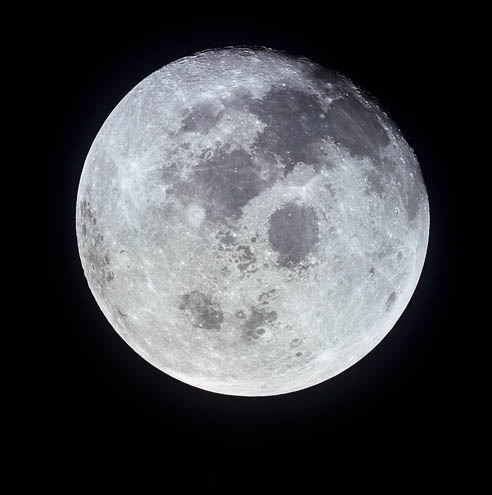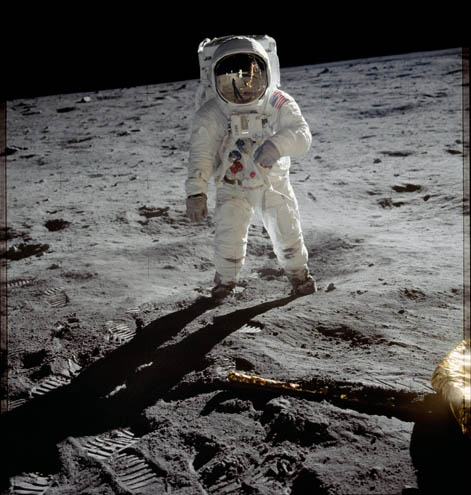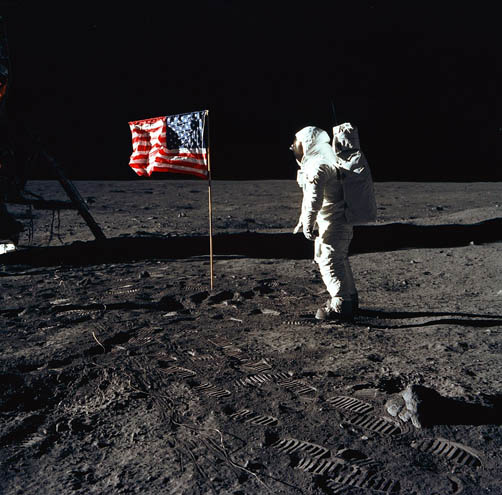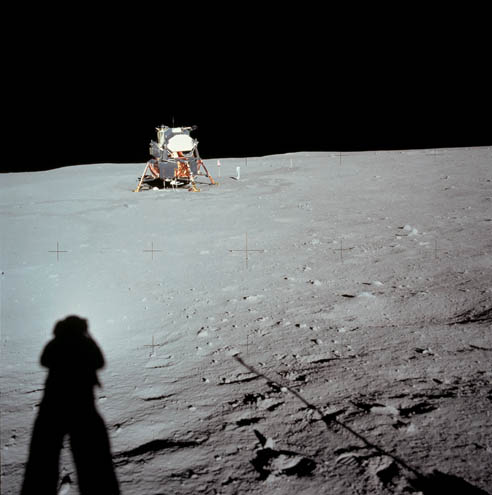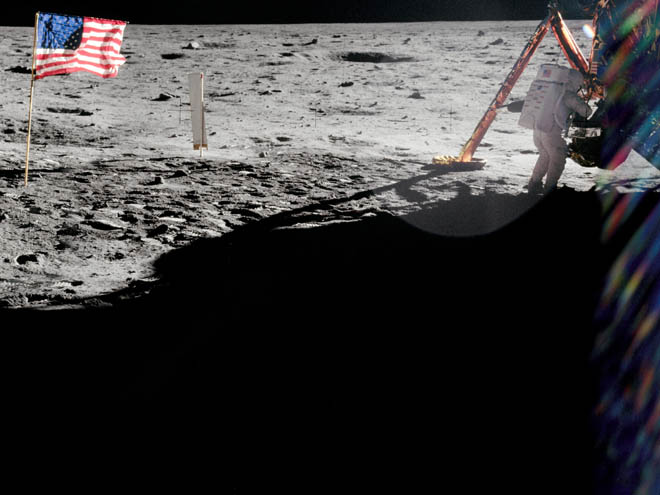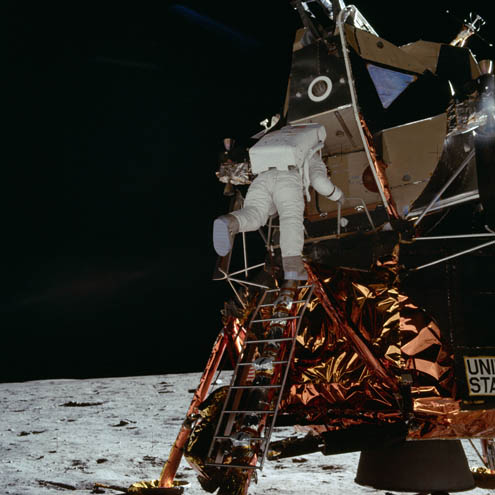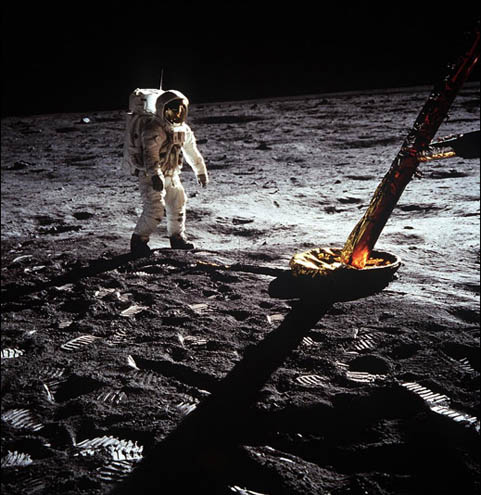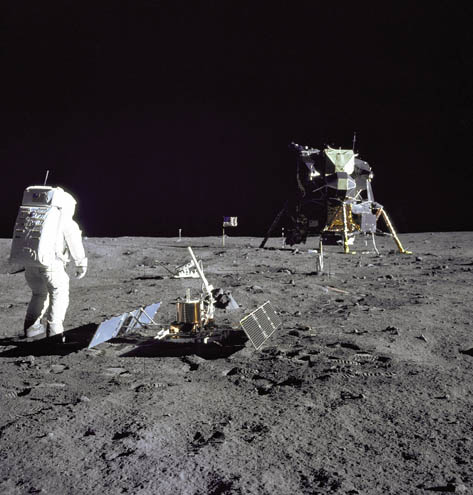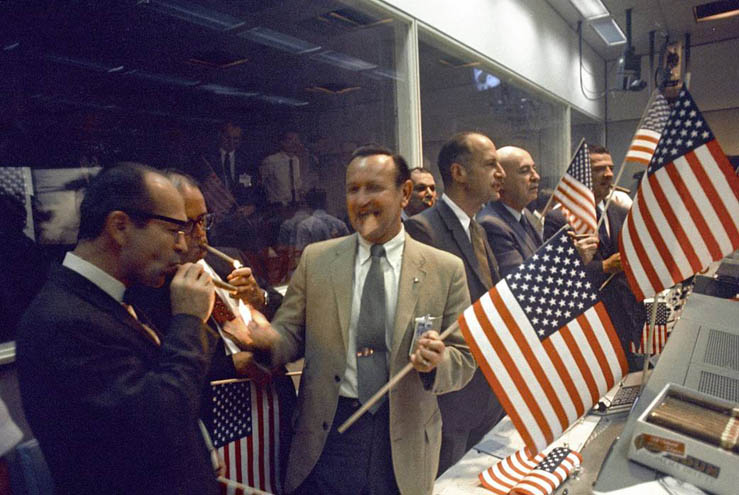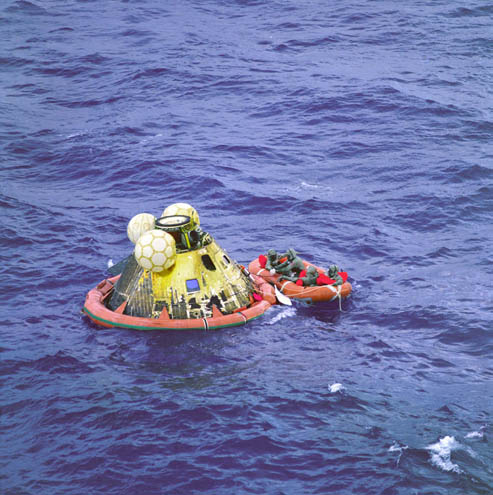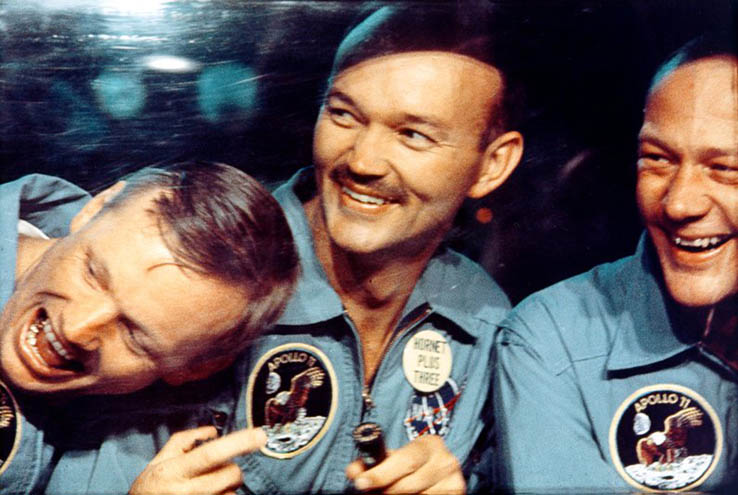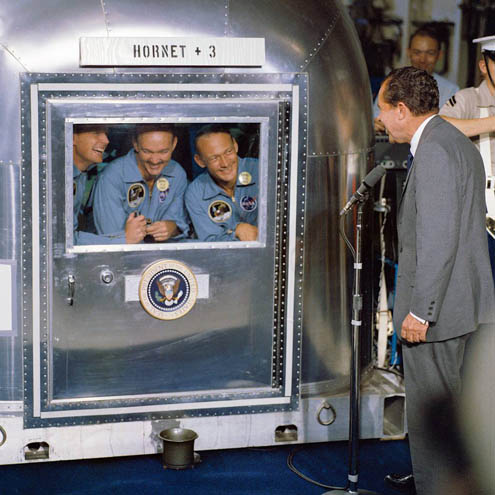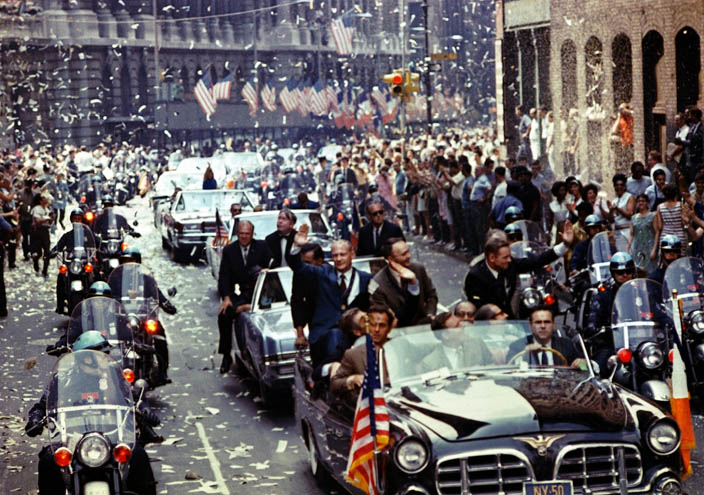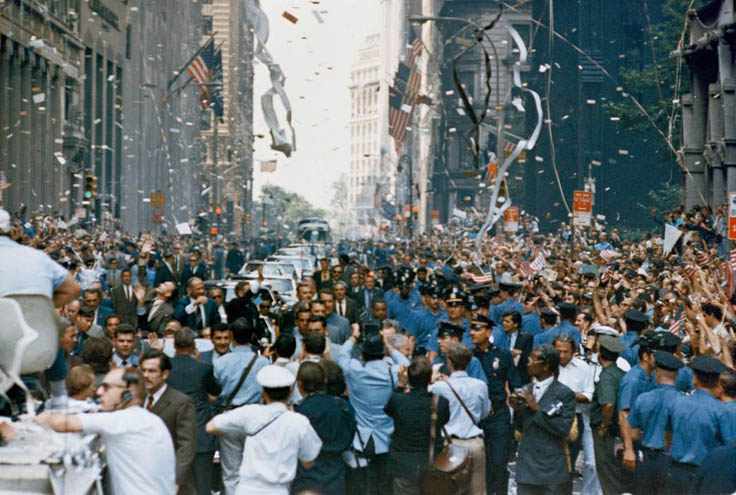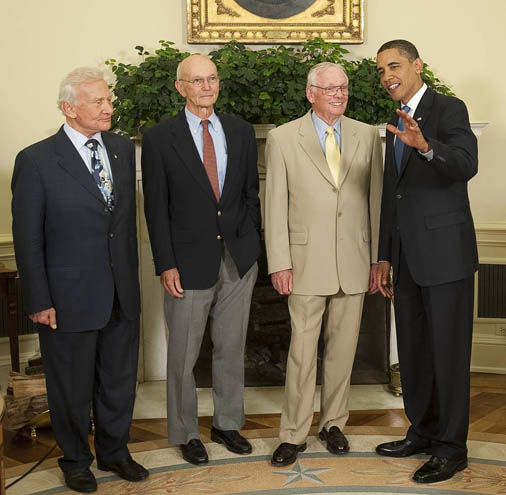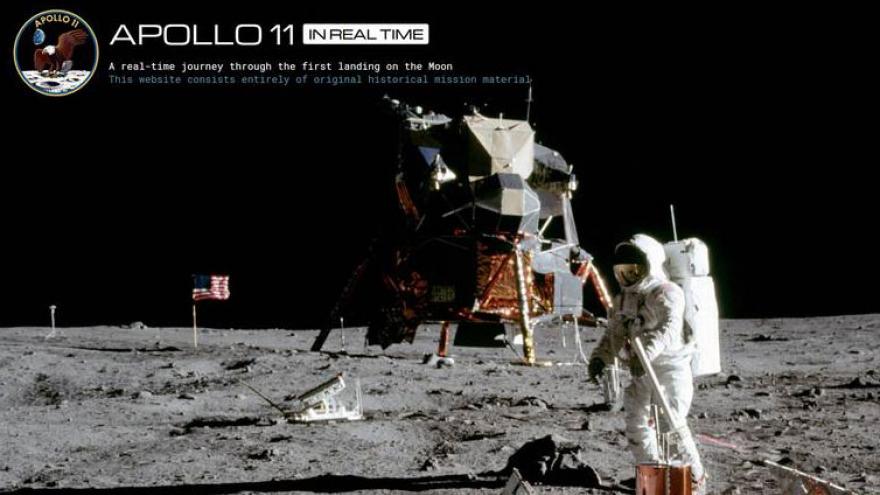The Apollo 11 Crew On Jan. 9, 1969, NASA announced the prime crew of the Apollo 11 lunar landing mission. This portrait was taken on Jan. 10, the day after the announcement of the crew assignment. From left to right are lunar module pilot Buzz Aldrin, commander Neil Armstrong; and command module pilot Michael Collins. Photo Credit: NASA
Official Apollo 11 crew portrait Official crew photo of the Apollo 11 Prime Crew. From left to right are astronauts Neil A. Armstrong, Commander; Michael Collins, Command Module Pilot; and Edwin E. Aldrin Jr., Lunar Module Pilot.
Apollo 11 Saturn V and mobile launcher begin journey to pad Carrying the Apollo 11 Saturn V rocket and mobile launcher, the crawler inches out of the Vehicle Assembly Building on the journey to Launch Pad 39A. The 363-foot-high space vehicle launched Apollo 11 astronauts Neil A. Armstrong, Michael Collins and Edwin E. Aldrin Jr. on the first manned lunar landing mission. Photo Credit: NASA
Apollo 11 rolls out Carrying the Apollo 11 Saturn V rocket and mobile launcher, the crawler inches its way along the three-and-a-half-mile journey to Launch Pad 39A. The 363-foot-high space vehicle launched Apollo 11 astronauts Neil A. Armstrong, Michael Collins and Edwin E. Aldrin Jr. on the first manned lunar landing mission. Photo Credit: NASA
Apollo 11 at Launch Pad 39A The 402-foot-tall mobile service structure is moved away from the Apollo 11 spacecraft at Kennedy's Launch Pad 39A. The move was made during the Countdown Demonstration Test with Apollo 11 astronauts Neil A. Armstrong, Michael Collins and Edwin E. Aldrin Jr. Photo Credit: NASA
Beginning the Apollo 11 Mission The Apollo 11 crew leaves Kennedy Space Center's Manned Spacecraft Operations Building during the pre-launch countdown. Mission commander Neil Armstrong, command module pilot Michael Collins, and lunar module pilot Buzz Aldrin prepare to ride the special transport van to Launch Complex 39A where their spacecraft awaited them. Photo Credit: NASA
Launch of Apollo 11 On July 16, 1969, the huge, 363-feet tall Saturn V rocket launches on the Apollo 11 mission from Pad A, Launch Complex 39, Kennedy Space Center, at 9:32 a.m. EDT. Photo Credit: NASA
Apollo 11 Lifts Off This photograph shows the Saturn V launch vehicle (SA-506) for the Apollo 11 mission liftoff at 8:32 am CDT, July 16, 1969, from launch complex 39A at the Kennedy Space Center. Photo Credit: NASA
Apollo 11 Liftoff The Apollo 11 Saturn V lifts off with astronauts Neil A. Armstrong, Michael Collins and Edwin E. Aldrin Jr. at 9:32 a.m. EDT July 16, 1969, from Kennedy's Launch Complex 39A. Photo Credit: NASA
View of Apollo 11 Liftoff From Launch Control Center July 16, 1969 - Personnel in the Launch Control Center watch the Apollo 11 liftoff from Launch Complex 39A at the start of the historic lunar landing mission. Photo Credit: NASA
Watching Apollo 11 Former President Lyndon B. Johnson and then-current Vice President Spiro Agnew are among the spectators at the launch of Apollo 11, which lifted off from Pad 39A at Kennedy Space Center at 9:32 am EDT on July 16, 1969. The crew, the first of the Apollo missions to land on the moon, safely returned to Earth on 37 years ago this week on July 24, 1969. Photo Credit: NASA
Apollo 11 Launch The American flag heralded the launch of Apollo 11, the first Lunar landing mission, on July 16, 1969. The massive Saturn V rocket lifted off from NASA's Kennedy Space Center with astronauts Neil A. Armstrong, Michael Collins, and Edwin "Buzz" Aldrin at 9:32 a.m. EDT. Four days later, on July 20, Armstrong and Aldrin landed on the Moon's surface. Photo Credit: NASA
Viewing History Adjacent to the Kennedy Space Center thousands of spectators camped out on beaches and roads to watch the launch of Apollo 11, which launched at 9:32 a.m. Eastern on July 16, 1969. The launch of Apollo 11 was the culmination of 8 years of hard work by thousands of scientists and technicians. Photo Credit: NASA
Apollo 11 Mission Officials Relax After Liftoff Apollo 11 mission officials relax in the Launch Control Center following the successful Apollo 11 liftoff on July 16, 1969. Photo Credit: NASA
Earth Rising over the Moon's Horizon This view of Earth rising over the Moon's horizon was taken from the Apollo 11 spacecraft. The lunar terrain pictured is in the area of Smyth's Sea on the nearside. Photo Credit: NASA
Full Moon Photographed From Apollo 11 Spacecraft This outstanding view of the full moon was photographed from the Apollo 11 spacecraft during its trans-Earth journey homeward. When this picture was taken, the spacecraft was already 10,000 nautical miles away. On board Apollo 11 were commander Neil Armstrong, command module pilot Michael Collins and lunar module pilot Buzz Aldrin. Photo Credit: NASA
Buzz Aldrin on the Moon Astronaut Buzz Aldrin walks on the surface of the moon near the leg of the lunar module Eagle during the Apollo 11 mission. Mission commander Neil Armstrong took this photograph with a 70mm lunar surface camera. While astronauts Armstrong and Aldrin explored the Sea of Tranquility region of the moon. Photo Credit: NASA
Apollo 11 Moonwalk Astronaut Edwin E. Aldrin Jr., lunar module pilot of the first lunar landing mission, poses for a photograph beside the deployed United States flag during an Apollo 11 extravehicular activity (EVA) on the lunar surface. The Lunar Module (LM) is on the left, and the footprints of the astronauts are clearly visible. Photo Credit: NASA
Lunar Module at Tranquility Base This photograph of the Lunar Module at Tranquility Base was taken by Neil Armstrong during the Apollo 11 mission, from the rim of Little West Crater on the lunar surface. Armstrong's shadow and the shadow of the camera are visible in the foreground. This is the furthest distance from the lunar module traveled by either astronaut while on the moon. Photo Credit: NASA
Neil Armstrong on the Lunar Surface As commander of Apollo 11, Neil Armstrong took most of the photographs from the historic moonwalk, but this rare shot from fellow moonwalker Buzz Aldrin shows Armstrong at work near the lunar module Eagle. Photo Credit: NASA
Aldrin Descends Lunar Module Ladder Astronaut Edwin E. Aldrin Jr., lunar module pilot, egresses the Lunar Module (LM) "Eagle" and begins to descend the steps of the LM ladder as he prepares to walk on the moon. Photo Credit: NASA
Aldrin walks on the surface of the moon Astronaut Edwin E. Aldrin Jr., lunar module pilot, walks on the surface of the moon near a leg of the Lunar Module during the Apollo 11 extravehicular activity (EVA). Astronaut Neil A. Armstrong, Apollo 11 commander, took this photograph with a 70mm lunar surface camera. The astronauts' bootprints are clearly visible in the foreground. Photo Credit: NASA
Aldrin Gazes at Tranquility Base Astronaut and Lunar Module pilot Buzz Aldrin is pictured during the Apollo 11 extravehicular activity on the moon. He had just deployed the Early Apollo Scientific Experiments Package. In the foreground is the Passive Seismic Experiment Package; beyond it is the Laser Ranging Retro-Reflector (LR-3). Photo Credit: NASA
Celebrating Apollo 11 NASA and Manned Spacecraft Center (MSC) officials joined with flight controllers to celebrate the successful conclusion of the Apollo 11 lunar landing mission in the Mission Control Center. Photo Credit: NASA
Apollo 11 Comes Home The Apollo 11 crew await pickup by a helicopter from the USS Hornet, prime recovery ship for the historic lunar landing mission. The fourth man in the life raft is a United States Navy underwater demolition team swimmer. Photo Credit: NASA
Crew awaits recovery July 24, 1969 - The Apollo 11 crew await pickup by a helicopter from the USS Hornet, prime recovery ship for the historic lunar landing mission. Photo Credit: NASA
Apollo 11 Crew In Quarantine President Richard M. Nixon was in the central Pacific recovery area to welcome the Apollo 11 astronauts aboard the USS Hornet, prime recovery ship for the historic Apollo 11 lunar landing mission.
Apollo 11 Welcome Home New York City welcomes the Apollo 11 crew in a ticker tape parade down Broadway and Park Avenue. Pictured in the lead car, from the right, are astronauts Neil A. Armstrong, Michael Collins and Buzz Aldrin. The three astronauts teamed for the first manned lunar landing, on July 20, 1969. Photo Credit: NASA
Apollo 11 Welcome Home New York City welcomes the Apollo 11 crew in a ticker tape parade down Broadway and Park Avenue. Pictured in the lead car, from the right, are astronauts Neil A. Armstrong, Michael Collins and Buzz Aldrin. The three astronauts teamed for the first manned lunar landing, on July 20, 1969. Photo Credit: NASA
Apollo 11 Crew Meets With President Obama President Barack Obama chats with Apollo 11 astronauts, from left, Buzz Aldrin, Michael Collins and Neil Armstrong, Monday, July 20, 2009, in the Oval Office of the White House in Washington, on the 40th anniversary of the Apollo 11 lunar landing. Photo Credit: NASA
Apollo 11 launched from Cape Kennedy on July 16, 1969, carrying Commander Neil Armstrong, Command Module Pilot Michael Collins and Lunar Module Pilot Edwin "Buzz" Aldrin.
Four days later, on July 20, Armstrong piloted the lunar module Eagle onto the moon's surface at 4:17 p.m EDT.
Six hours later, at 10:56 p.m., Armstrong stepped out of the lunar module and onto the moon.
Over 500 million people watched the event on television as Armstrong said, "That's one small step for a man, one giant leap for mankind."
Twenty minutes later, Aldrin stepped onto the surface.
While on the surface, Aldrin deployed the Early Apollo Scientific Experiments Package and both astronauts gathered lunar surface samples.
After Aldrin spent one hour and 33 minutes on the surface, he returned to the lunar module.
Armstrong re-entered the lunar module 41 minutes later.
On July 24, after 8 days, 3 hours 18 minutes and 35 seconds in orbit, Apollo 11's crew landed in the Pacific Ocean.
The crew traveled 953,054 miles and into history.

